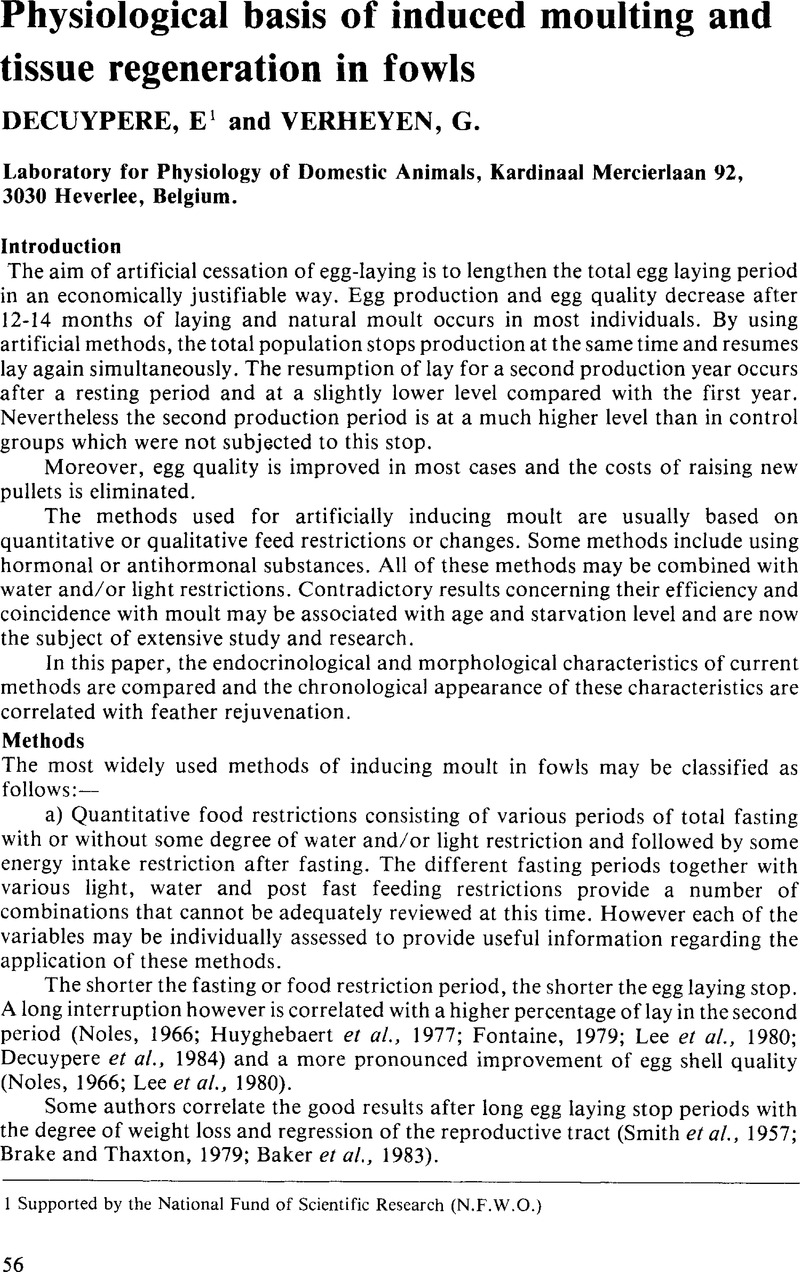Crossref Citations
This article has been cited by the following publications. This list is generated based on data provided by Crossref.
ANDREWS, D.K.
BERRY, W.D.
and
BRAKE, J.
1987.
Effect of Lighting Program and Nutrition on Feather Replacement of Molted Single Comb White Leghorn Hens ,.
Poultry Science,
Vol. 66,
Issue. 10,
p.
1635.
Hoshino, S
Yamada, Y
Kakeoawa, T
Suzuki, M
Wakita, M
and
Kobayashi, Y
1988.
Changes in thyroxine and triiodothyronine during spontaneous molt in the hen, gallus domesticus.
Comparative Biochemistry and Physiology Part A: Physiology,
Vol. 91,
Issue. 2,
p.
327.
Herremans, M.
Decuypere, E.
and
Chiasson, R. B.
1988.
Role of ovarian steroids in the control of moult induction in laying fowls.
British Poultry Science,
Vol. 29,
Issue. 1,
p.
125.
Hoshino, S.
Suzuki, M.
Kakegawa, T.
Imai, K.
Wakita, M.
Kobayashi, Y.
and
Yamada, Y.
1988.
Changes in plasma thyroid hormones, luteinizing hormone (LH), estradiol, progesterone and corticosterone of laying hens during a forced molt.
Comparative Biochemistry and Physiology Part A: Physiology,
Vol. 90,
Issue. 2,
p.
355.
Balthazart, J.
Verheyen, G.
Schumacher, M.
and
Decuypere, E.
1988.
Changes in progesterone metabolism in the chicken hypothalamus during induced egg laying stop and molting.
General and Comparative Endocrinology,
Vol. 72,
Issue. 2,
p.
282.
DICKERMAN, R.W.
and
BAHR, J.M.
1989.
Molt Induced by Gonadotropin-Releasing Hormone Agonist as a Model for Studying Endocrine Mechanisms of Molting in Laying Hens.
Poultry Science,
Vol. 68,
Issue. 10,
p.
1402.
Tilbrook, A. J.
Johnson, R. J.
Eason, P. J.
Walsh, J. D.
Trigg, T. E.
and
Clarke, I. J.
1992.
Short‐term reduction in egg production in laying hens treated with an agonist of GnRH.
British Poultry Science,
Vol. 33,
Issue. 3,
p.
621.
Jacquet, J. M.
Seigneurin, F.
and
De Reviers, M.
1993.
Effect of thyroxine on testicular function, circulating luteinising hormone and pituitary sensitivity to luteinising hormone‐releasing hormone in the cockerel (Gallus domesticus).
British Poultry Science,
Vol. 34,
Issue. 4,
p.
803.
BRAKE, J.
1993.
Recent Advances in Induced Molting.
Poultry Science,
Vol. 72,
Issue. 5,
p.
929.
Jacquet, J. M.
Seigneurin, F.
and
De Reviers, M.
1993.
Induced moulting in cockerels: Effects on sperm production, plasma concentrations of luteinising hormone, testosterone and thyroxine, and on pituitary sensitivity to luteinising hormone‐releasing hormone.
British Poultry Science,
Vol. 34,
Issue. 4,
p.
765.
Su, H.
Silversides, F. G.
and
Villeneuve, P.
1995.
Ovarian morphology and follicular development in sex‐linked imperfect albino (sal‐s) and nonalbino hens before or after a forced moult.
British Poultry Science,
Vol. 36,
Issue. 4,
p.
645.
Yoshimura, Y
Heryanto, B
and
Tamura, T
1997.
Changes in the population of proliferating cells in chicken anterior pituitary during induced molting: an immunocytochemical analysis for proliferating cell nuclear antigen.
Poultry Science,
Vol. 76,
Issue. 11,
p.
1569.
Heryanto, B.
Yoshimura, Y.
Tamura, T.
and
Okamoto, T.
1997.
Involvement of apoptosis and lysosomal hydrolase activity in the oviducal regression during induced molting in chickens: a cytochemical study for end labeling of fragmented DNA and acid phosphatase.
Poultry Science,
Vol. 76,
Issue. 1,
p.
67.
MCNABB, F. M. ANNE
2000.
Sturkie's Avian Physiology.
p.
461.
Chowdhury, V.S.
and
Yoshimura, Y.
2002.
Cell Proliferation and Apoptosis in the Anterior Pituitary of Chicken during Inhibition and Resumption of Laying.
General and Comparative Endocrinology,
Vol. 125,
Issue. 1,
p.
132.
IWASAWA, Atsushi
NAKAYAMA, Hirofumi
YAMAMOTO, Yoshio
DOI, Osamu
NAKAMURA, Takao
and
KATO, Yukio
2002.
Specific Anti-peptide Antibody to β Subunit of Chicken Thyrotropin: Production and Characterization.
Journal of Reproduction and Development,
Vol. 48,
Issue. 2,
p.
197.
Tona, K.
Bamelis, F.
De Ketelaere, K.B.
Bruggeman, V.
and
Decuypere, E.
2002.
Effect of Induced Molting on Albumen Quality, Hatchability, and Chick Body Weight from Broiler Breeders.
Poultry Science,
Vol. 81,
Issue. 3,
p.
327.
IWASAWA, Atsushi
KATO, Yukio
HISHIKAWA, Tomoko
DOI, Osamu
KAMIYOSHI, Michiharu
and
NAKAMURA, Takao
2002.
Changes in Thyrotropin Messenger RNA and Circulating Hormone Levels during Induced Molting of the Hen (<i>Gallus domesticus</i>).
Journal of Reproduction and Development,
Vol. 48,
Issue. 5,
p.
489.
Cheng, FP
Guo, TJ
Wu, JT
Lin, TE
Ursem, PJ
Colenbrander, B
and
Fung, HP
2002.
Annual variation in semen characteristics of pigeons (Columba livia).
Poultry Science,
Vol. 81,
Issue. 7,
p.
1050.
Bell, DD
2003.
Historical and current molting practices in the U.S. table egg industry.
Poultry Science,
Vol. 82,
Issue. 6,
p.
965.



